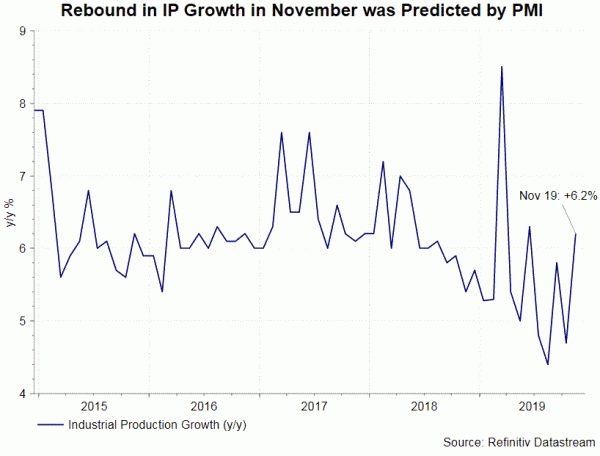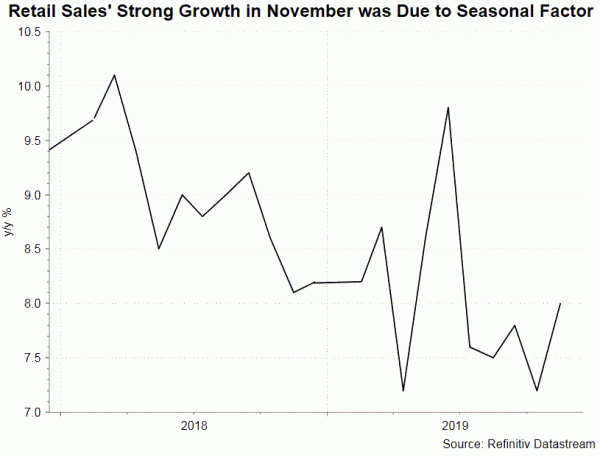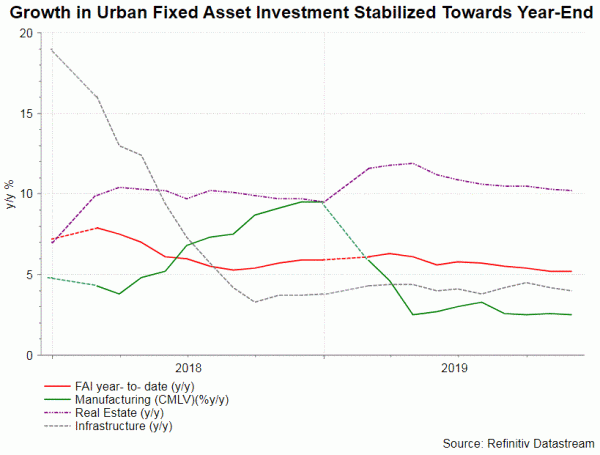A number of good news has increased optimism over China. Following announcement of a Phase I trade deal with the US, the latest set of economic data surprised to the upside in November. However, we expect the bullishness will be short-lived. For the year ahead, the government will have to continue stimulating the economy via fiscal and monetary measures.
Last week, the media disclosed that the US and China has agreed to a Phase 1 trade deal. China will buy US$ 200B worth of US goods (agricultural, energy and tech) in 2 years. Agricultural products constituted about 20% (US$40-50B) of total purchases. Moreover, China has agreed to open up its financial services sector and to enact new protections against intellectual property theft. In return, the US has suspended tariffs (15%) on US$160B in Chinese exports. This was supposed to take effect on Dec 15. Furthermore, the US has agreed to reduce to 7.5% tariff on US$120B of Chinese goods (from 15%). The original 25% tariff on US$250 of Chinese exports will be maintained. We would like to emphasize that the timing of signing the deal is not confirmed. Meanwhile, the small tariff reduction by the US should offer little help to China’s exports and supply chain.
Released earlier this week, Chinese economic data improved across the board. Industrial production grew +6.5% y/y in November, accelerating form +4.7% a month ago. While the reading has beaten consensus of +5%, the strength is not too surprising. As we mentioned in a report two weeks ago, stronger than expected manufacturing PMI signaled that IP growth should have accelerated in November. Retail sales expanded 8% y/y, up from +7.2% in October. The market had anticipated a +7.6% growth. Retail sales usually spike in November, as driven by seasonal factor – Double-11 festival. Urban fixed asset investment gained +5.2% y/y in the first 11 months of the year, same growth rate as the first 10 months. It is too early to conclude that China’s economy has bottomed out.
At the annual Central Economic Work Conference (CEWC) last week, the key message conveyed by Chinese officials is “stability”. The statement emphasized the “six stability”. Stabilising GDP growth at “around 6%” is the top priority. The government signaled that proactive fiscal policy and prudent monetary policy will be implemented to stabilize the economy. At the meeting, the officials noted that they plan to consolidate the impact of tax cuts this year, signaling further cuts are not likely. Fiscal stimulus will likely be implemented via government spending. Indeed, mentioning of “infrastructure investment” in the statement suggests that this will be a key to support growth. “Prudent” is a usual term accompanying monetary policy in China, whether it is in easing or tightening cycle. The statement noted that “credit and total social financing growth should fit economic development”. The new reference of “fit economic development” is again ambiguous. Given the priority of growth stabilization, China’s monetary policy should be tilted to the easing side. Another hint to the easing bias is the lack of reference to elevated inflation. Headline inflation soared to 4.5% y/y in November, compared with PBOC’s target of +3%. The lack of coverage on inflation suggests that the government intends to consider it as a temporary phenomenon which should not affect monetary easing.















